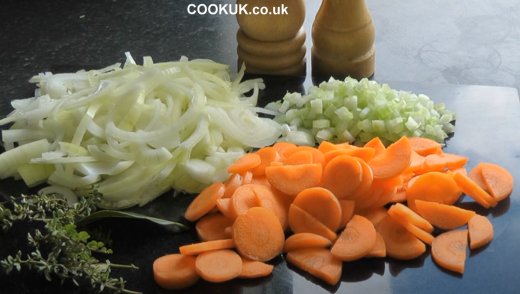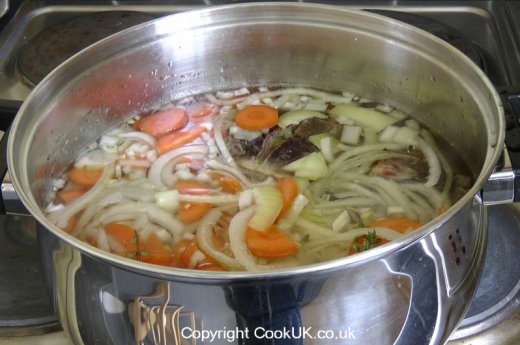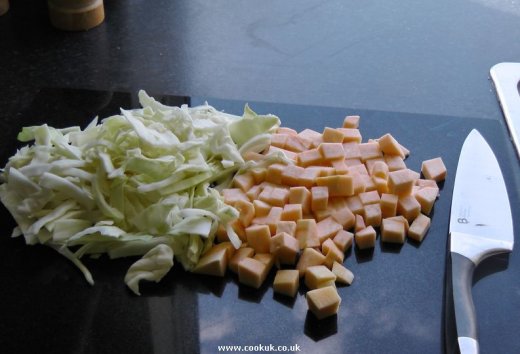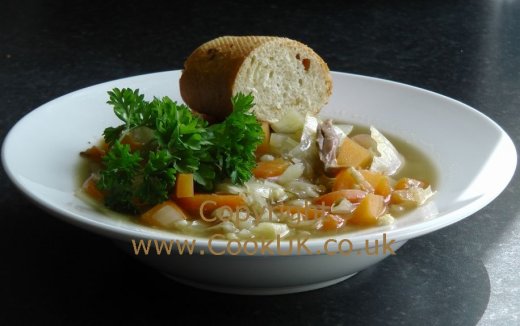Scotch Broth is a traditional Scottish meal that is based around a few essential ingredients. Mutton or lamb is central and cheaper cuts are used, such a neck or shin. Pearl Barley and, nowadays, lentils are used to thicken the broth.
To illustrate how far today's Scotch Broth differs from the really traditional recipe, see "A New System Of Domestic Cookery" first published in 1806. Note the unsurprising lack of lentils.
Neck of lamb is not only available from your local butcher; supermarkets such as Tesco sell Lamb Neck Fillets and these are good for Scotch Broth. The fillets however, do not have any bones so slightly lack some of the flavour compared to the neck of lamb on the bone which you would buy from your butcher.
Root vegetables are another key ingredient in Scotch Broth, commonly being carrots and swede. However, different rroot vegetables are often added depending on what is in season. Onions and celery are essential ingredients.
Not surprisingly, Scotch Broth tastes better when left in the fridge overnight and re-heated the next day, the flavours are more intense. Cooling in the fridge also has the benefit that the fat in the broth will rise to the surface and form a crust which can easily be removed if you want. This broth makes an excellent main course meal when served with either crusty bread or potatoes.
There is no definitive recipe for Scotch Broth, there are hundreds of variations, even when served in Scotland. It is a great way of using up leftover vegetables or when you have an excess from your own garden.
600g / 1lb 6oz neck of lamb or mutton
2 medium carrots
2 medium onion
1 stick celery
150g / 5oz (when chopped) swede
300g / 11oz white cabbage
60g / 2 oz pearl barley (see Advice section below)
45g / 1½ oz green split peas or lentils (see Advice section below)
A handful of parsley plus four sprigs to garnish the served soup
Salt and pepper to taste

![]()
Scotch Broth vegetables prepared
Wash the carrots and outside of the cabbage.
Top and tail then roughly slice the carrots.
Peel the onions, top and tail them and roughly slice.
Finely chop the celery.
The swede can be peeled and chopped later on whilst the main ingredients of the Scotch Broth are cooking
Scotch Broth is ideal for freezing and it will also keep for three or four days im the fridge.
The split peas or lentils we use for this recipe do not require overnight soaking, check that this is the case with ones you buy. We suggest green split lentils because this is common to many Scotch Broth recipes. However yellow or red split lentils make excellent alternatives if you already have them in your cupboard.
Pearl Barley comes in a few forms, some require soaking overnight others requiring around an hours cooking time. Our Pearl Barley required cooking for 1 hour and ten minutes. Read the instructions on the pack carefully and add your Pearl Barley either earlier or later in the cooking process depending on how long the pack indicates it should be cooked for.
Root vegetables are the main ingredients in Scotch Broth, commonly being carrots, onions and either turnip or swede. However, different vegetables are often added depending on what is in season. Turnips and celery are typical additional ingredients.
The cut of meat also varies depending on what is to hand. Instead of lamb, beef is often used and less commonly chicken.
Not surprisingly, Scotch Broth tastes better when left in the fridge overnight and re-heated the next day, the flavours are more intense. Cooling in the fridge also has the benefit that the fat in the broth will rise to the surface and form a crust which can easily be removed. This broth makes an excellent main course meal when served with either crusty bread or potatoes.
Place the neck of lamb / mutton into a large pan, add about 1½ litre of water and bring to the boil on a medium heat. Let it boil for five minutes and a scummy froth will appear on the surface of the water. Scoop off the scum but retain the water to use in step 2 below.
STEP 2Add the neck of lamb to the retained water from step 1 above and then add the onions, carrots and celery. Season with a little salt and pepper. More salt and pepper can be added later if required when the soup is cooked. Bring the broth to a boil and then turn down the heat to just a simmer. Cook for 1 hour.

![]()
Vegetables added to Scotch Broth
While the broth is cooking in step 2 above, shred the cabbage.
The swede should be peeled and cut into 1.5cm cubes. Use a stout and sharp knife to do this because because swede is hard to cut.
STEP 4We now add the Pearl Barley and split peas to the Scotch Broth, stir well and continue to cook for a further 30 minutes.
Finally add cabbage and swede to the broth. Stir these in well and cook for an additional 40 minutes. Add more hot water if the soup dries out.

![]()
Add cabbage and swede to Scotch Broth
Take each piece of the neck of lamb from the pan and separate the meat from fatty gristle and bone. It's easy to do this with a knife and fork.
Cut any larger bits of lamb into smaller chunks then add the meat back to the pan and cook for five more minutes.
STEP 6Have a taste of the Scotch Broth and add more salt and pepper as required.
Serve into large bowls and garnish with a sprig or two of parsley. Serve with crusty bread. It will keep in the fridge for a couple of days and tastes even better for it!

![]()
Scotch Broth and crustry bread
| Not Given | 8 August 2012 | From: Not Given |
| Hey Martin, turn the heat right down and simmer it gently. | ||
|
|
21 November 2012 | From: Not Given |
| I also added celeriac and for a veggie option sweet potato, mushrooms served in a Yorkshire pudding lovely xx | ||
|
|
12 January 2011 | From: Martin |
| I made this soup tonight and it was delicious. I always buy scotch broth tins from the supermarket and thought id try making it myself, it tasted so much better! The only thing I found was that all the water was nearly gone by the time the soup was ready, I don't know if its cos there was so many ingredients in the pot but i just topped it up with boiling water and it fixed it right away :) will definitely be making this again. | ||